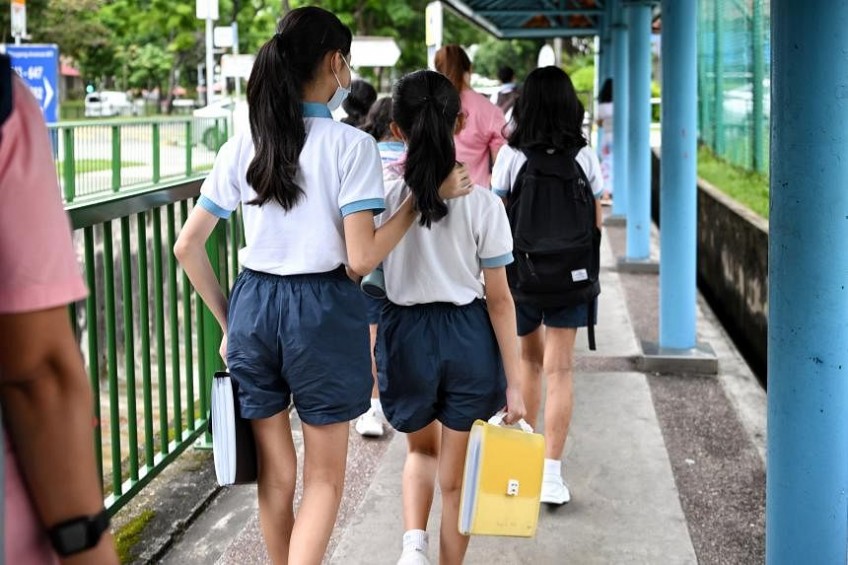Some schools advise students to wear PE attire amid Singapore's blistering heat


SINGAPORE - Some schools have advised students to dress in physical education (PE) attire until further notice, in the light of persistently high temperatures in recent weeks.
According to parents of primary and secondary school-age children The Straits Times spoke to, at least 10 schools have eased uniform regulations to varying degrees or are planning to.
This comes after the Meteorological Service Singapore (MSS) on March 23 said the island’s temperatures in 2024 could soar even higher than in 2023 – the country’s fourth-warmest year since records began in 1929.
According to the MSS website, the highest temperature Singapore has experienced so far in 2024 was 36.3 deg C on March 24, with maximum daily temperatures expected to be around 34 deg C and 35 deg C until the end of the month.
The National Environment Agency also urged people to put on more sunscreen and keep umbrellas and hats handy, after the ultraviolet index hit extreme levels in the afternoon of March 27.
Bukit Timah Primary School, which has eased uniform regulations, is allowing pupils to swop formal uniform shirts for PE T-shirts if they wish to do so.
In a letter addressed to parents on March 22, the school said the move was made in consideration of the warmer weather and pupils’ comfort.
Lianhua Primary School has also given its pupils the choice to wear PE shorts instead of formal bottoms during this hot season, said the school’s advisory commitee member Esther Foong, 39.
She added that the school’s uniform top is made of dri-fit fabric with moisture-wicking properties.
The school has also spoken to students about the risks associated with hot weather and precautions to take. This includes teaching students the importance of hydration, recognising signs of heat exhaustion or heat stroke, and understanding when to seek shade or cool down indoors.
[[nid:677187]]
But some schools have yet to make such adjustments, sparking concern among some parents.
A parent of a Primary 2 pupil attending a school in Marine Parade said her child’s school has not made any uniform arrangements to help the children cope with the heat.
The parent, who wanted to be known only as Ms Lek, added that the pupils are also required to wear their pinafores over their PE attire outside of PE classes.
While she said the school’s uniform is “elegant and the girls look very smart in it”, having to wear multiple layers is becoming increasingly unbearable as temperatures continue to rise.
She said: “My girl usually comes home drenched in perspiration and flushed red due to how warm she feels after walking in the hot afternoon sun.
“It would really help if the school would consider allowing the girls to show up in their PE uniform, such as the neighbouring primary school does for its students.”
Another parent, who wanted to be known only as Mr Chan, said he has two secondary-age daughters attending different schools. While both school uniforms include pinafores, only one school has eased the uniform regulations.
“As a parent, I’d rather my daughter be comfortable. The school should be flexible and understanding in view of what is going on,” he said.
Mr Chan added that he is not overly concerned as his daughter is old enough to take care of herself, but he noted that parents of primary school children may worry more as younger children could be less adept at spotting signs of dehydration or voicing out concerns.
Mrs Foong, who has two children, said parents should not place too much stress on schools and that teaching children how to cope with hotter weather should start at home.
She said she reminds her children to refill their water bottles at least twice while in school, making the habit more intuitive when teachers reinforce it.
“Parents and caregivers should take on the role of ensuring good health,” she said, adding that she does not include chocolate or “heaty” food in her children’s snack boxes and tries to provide healthier meals at home.
In response to queries, the Ministry of Education (MOE) said on March 27 that schools work with MOE guidelines and have measures in place to ensure the safety and well-being of students and staff when faced with hot weather conditions.
One such measure is allowing students to dress in PE attire or school T-shirts, depending on their specific needs.
Outdoor physical activities are also minimised during hotter parts of the day and students are encouraged to stay hydrated throughout such activities to prevent exercise-induced heat strain.
“MOE and schools will continue to monitor the heat situation and the well-being of students and staff closely, especially those who may be more vulnerable to the effects of higher temperature conditions,” the ministry said.
It did not elaborate on the thresholds used to determine high temperatures.
Adjunct Professor Malcolm Mahadevan, a senior consultant in the Emergency Medicine Department at the National University Hospital, said PE attire is usually lighter and more sweat-wicking than formal uniforms and allows the body to cool faster.
He added that students should not exercise with additional layers of clothing during this period as the additional heat increases the risk of mild to severe heat-related injuries.
“Heat-related injury spans from crisis, exhaustion, and the most severe of which is heat stroke, which is rare but can be fatal,” he said, adding that early symptoms of heat strokes can include rash and cramps.
While Prof Mahadevan advised people to stay indoors as much as possible, he said those who are participating in physical activities should do so in the shade, pace out the activity and preemptively drink more water.
“Anytime anyone feels unwell, stop and move into the shade, drink plenty of water and cool down with water mists and fans,” he said.
[[nid:676579]]
This article was first published in The Straits Times. Permission required for reproduction.